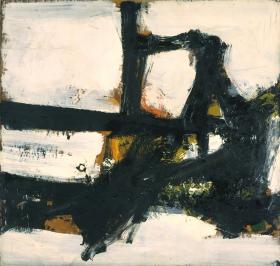1. Assign the class to examine Orange Outline and Berkeley No. 8.
2. Conduct a brainstorming session in which students provide one-word descriptions or adjectives that come to mind as they view the Kline and Diebenkorn paintings. Write the words on the board in no particular order.
3. Hold a brief class discussion focusing on grouping the words from the brainstorming exercise into categories. Ask students to think of a category and then select the words that reflect that category. How do these categories and words relate to the painting? How did the artist create those references? What specific elements of the works of art helped you generate these words?
After the initial discussion of the words, direct the students to consider the following questions about place: What kinds of places do these works remind you of? What do these two works tell us about urban and rural environments? What do the works tell us about their time periods? What kinds of sounds do you associate with the two environments?
Briefly discuss the connection between urban environments and abstract expressionism using the background material on abstract expressionism.
4. Have the students read the New York Times article about the music of Morton Feldman and his relationship to abstract expressionism.
5. Play the YouTube video “For Franz Kline” by Morton Feldman, and discuss the relationship between the paintings and the music.
6. Assign students to paint two images: one based on their interpretation of or feelings about Kline's Orange Outline and one based on their interpretation of or feelings about Diebenkorn's Berkeley No. 8. Replay the song “For Franz Kline” by Morton Feldman while they work. Direct students to incorporate aspects of place into each of their works. Ask for volunteers to discuss their paintings with the class and explain how they used the music and the two Museum paintings for inspiration.
- The teacher will use the brainstorming and group exercise, class discussion, and the painting to assess the students’ analysis of the abstract works of art and their relationship to sound and place.
abstract
expressionism
improvisation
interpretation
inspiration
landscape
paper, paints, and paintbrushes
Fairbrother, Trevor, and Potts, Kathryn. In and Out of Place: Contemporary Art and the American Social Landscape. Boston: Museum of Fine Arts, 1993.
Hughes, Robert. American Visions: The Epic History of Art in America. New York: Alfred A. Knopf, 1997.
Menkes, Diana, ed. Of Time and Place: American Figurative Art from the Corcoran Gallery. Washington, D.C.: Smithsonian Institution Press, 1985.
Wilmerding, John. American Masterpieces from the National Gallery of Art. New York: Hudson Hills Press, 1980.
Information on Abstract Expressionism from Metropolitan Museum of Art
Connection between urban environments and Abstract Expressionism
Morton Feldman recording of “For Franz Kline” on YouTube
For information on the connection between music and abstract expressionism:
- “Imaging Music: Abstract Expressionism and Free Improvisation” by Matthew Sansom. Leonardo Music Journal Vol. 11, Not Necessarily "English Music": Britain's Second Golden Age (2001), pp. 29–34
Franz Kline's brash and freewheeling art wells from a distinctively urban, specifically New York sensibility. (He claimed to prefer the roar of traffic to the peace of the country.) Each of his paintings is a clamorous construction site, built stroke by stroke, revised and reworked. In Orange Outline the seemingly haphazard swaths of tar-black paint suggest an iron framework supporting the composition. The painting barely contains the energies of its making. Furthermore, it gains a gritty honesty by the deliberate, blatant roughness of its execution and the poverty of materials: cheap, commercial house paint slathered on a flimsy sheet of paperboard.
Kline insisted his most successful paintings were visual responses to a specific emotional state. Describing his images as "painting experiences," he explained, "I don't decide in advance that I'm going to paint a definite experience, but in the act of painting, it becomes a genuine experience for me."
Richard Diebenkorn's paintings have been rightly termed "abstract landscapes": a description exemplified by Berkeley No. 8, which belongs to a series created while the artist was living across the bay from San Francisco.
The painting summarizes the artist's quickened perceptions of color and space. Rather than plan, Diebenkorn improvises, discovering the picture's image through trial and error. He has built the composition (reportedly inspired by aerial views of the American Southwest) of blocks of color. Diagonals slice and fracture the horizontal elements of the design. Most remarkable is the quality of light, a synthesis of the parched colors of New Mexico and the sparkle of the Pacific Ocean.


